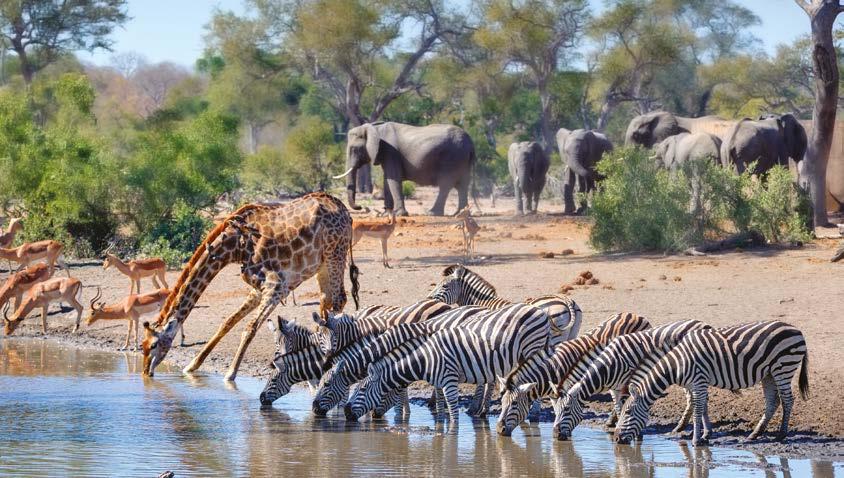Riri: My South Africa






1 2 3 4 5 www.eligradedreaders.com
This story is about a South African teenager called Riri. Her days are busy and full of fun, especially with her Italian friend, Claudia. She loves animals and dreams of working with them one day.
A competition gives her the chance to make her dream come true.
Main themes include nature, friendship and traditions.


















































































In this reader:
21st Century Skills
Key
Glossary
To encourage students to connect the story to the world they live in.
A2 level activities.
Explanation of difficult words.
These icons indicate the parts of the story that are recorded.
Audio start stop
The FSC® certification guarantees that the paper used in these publications comes from certified forests, promoting responsible forestry management worldwide.
For this series of ELI graded readers, we have planted 5000 new trees.


The ELI Readers collection is a complete range of books and plays for readers of all ages, ranging from captivating contemporary stories to timeless classics. There are four series, each catering for a different age group: First ELI Readers, Young ELI Readers, Teen ELI Readers and Young Adult ELI Readers. The books are carefully edited and beautifully illustrated to capture the essence of the stories and plots. The readers are supplemented with ‘Focus on’ texts packed with background cultural information about the writers and their lives and times.
The Publisher would like to thank Claudia Signorile for her precious support.
Riri: My South Africa
Grace Lani
English Version and activities
Silvana Sardi
ELI Readers
Founder and Series Editors
Paola Accattoli, Grazia Ancillani, Daniele Garbuglia (Art Director)
Real Lives Series Creation
Grazia Ancillani
Graphic Design
Emilia Coari
Production Manager
Francesco Capitano
Photo credits Shutterstock
First edition: 2023
© ELI s.r.l. P.O. Box 6 62019 Recanati (MC)
Italy
T +39 071750701
F +39 071977851
info@elionline.com
www.elionline.com
Typeset in 12 / 17 pt
Fulmar designed by Leo Philp
Printed in Italy by Tecnostampa - Pigini Group Printing Division
Loreto - Trevi (Italia)
ERT330.10
ISBN 978-88-536-3969-1

1 Choose the best words (A, B or C) to complete the text below.

This story is about a South African girl
(1) Riri. South Africa is the southernmost country in the continent of Africa and



(2) _________ sixty million people live there. Its largest city is Johannesburg, often known as ‘The City of Gold’ as it’s famous (3) its gold and diamonds.
In South Africa, there is a (4) variety of different cultures, languages and religions. If you visit this country, you can try different kinds of food from these various cultures. They eat a lot of meat and really like having a ‘braal’, which is a special kind of barbecue.
(5) of different sports are also played in South Africa. The most popular are football, rugby and cricket. South Africa is also a (6) beautiful country, with wonderful beaches, mountains, forests and desert areas. 1
2 Here are just some of the animals you can find in South Africa. Match the photos to the correct name.
a giraffe

b cheetah
c leopard


d gazelle

e hyena

f hippopotamus (hippo)

g crocodile

h rhinoceros (rhino)

i lion

3a Write a short paragraph about your country like the text in exercise 1.
3B Discuss with a partner about your country and South Africa. How are they the same and in what ways are the two countries different?
4 Listen to the start of Chapter 1 and decide if the sentences are true (T) or false (F). T F
1 People in South Africa don’t usually have short names.
2 Riri always has a lot to do every day.
3 She never gets up early in the morning.
4 School starts at a quarter past seven.
5 Each lesson is usually less than an hour long.
6 Riri stays in the same classroom for all her lessons.
Hi, my name’s Rirhandzu!


Actually, my full name’s Rirhandzu Tlangelani Xiluva Chauke. Are you maybe thinking that it’s a bit too long? Well, in South Africa, names are often long because they have a special, important meaning. Take my name for example: ‘Rirhandzu’ means ‘love’, ‘Tlangelani’ means to ‘celebrate or rejoice’, and ‘Xiluva’ means ‘beautiful flower’. Anyway, everyone calls me Riri, which is short for Rirhandzu. Chauke is my surname.



My days are busy and full of fun, but the worst moment for me is the morning because I have to get up at 6 o’clock. I just love sleeping late!
My days are busy and I have to get up at Justanotherfive minutesplease!

All students like me must arrive at school on time. The bell rings at 7.45 a.m. and the teacher for the first hour immediately calls out our names to see if we’re all there. Then we start our lessons, which are about 50 minutes long. Sometimes they can be a bit longer if we have to do Cycle Tests, which are class tests on all our different subjects. These tests are really difficult and we need to study hard for them! Every time we change subject, we also change classroom and classmates, so there’s never a boring moment!
There are lots of different subjects; some we have to do, others we can choose to do or not do. We study English, maths, Afrikaans, biology, law, physics, geography, music, history, drama* and art. There are lots of rules* that we must follow and we also have to wear a uniform. Here I am getting ready for school!
study English, maths, Afrikaans, biology, must follow and we also












Somanybuttons!
drama the theatre and actors rules what you can and can’t do
We must all study four subjects: Afrikaans, English, maths and life orientation, which is a kind of Civic Education. From grade 10 to 12 of High School, we choose what other subjects we want to study among art, physics, chemistry, history and science.


In South Africa, most children go to Kindergarten, known as Grade 0, before starting Elementary School (grades 1-6). All students must then go to Secondary School up to Grade 9 because all children in South Africa have to go to school from the age of 5 or 6 until they are 15 years old.















This part of High School is known as ’Further Education and Training’ or FET. Students don’t have to do these three years, so usually only students who want to continue their studies, for example at a university, stay at school until they’re 18 years old. At the end of Grade 12, there are exams for the National Senior Certificate. This School Leaving Exam is called the “Matric”.



The last year of High School is called Matric, like the name of the School Leaving Exam. We have a month’s holiday from school every three months, so it’s not that bad. We start in January and finish at the end of March. Then we stop for the month of April and start again in May until the end of July. July is a hard month for us because it’s full of exams on all our subjects! Then it’s holiday time again in August and we can relax a bit before starting again in September. The school year finishes with the final exams in November. So, as you can see, April, August and December are the three months when we’re on









Here I am during my art lesson. Here I am during my art lesson.Artiscool!Iloveit!
holiday, which is great because we get a break from all that studying and best of all, one of these breaks is in summer, my favourite season. We don’t just have to pass all our exams to get into the following year, but we also have to do ten hours of useful work without getting paid for it. This is part of a school project called Community Service. There are lots of activities to choose from, like dog sitter, babysitter, or helping people in need to do their shopping etc. I love animals so I always choose to take dogs for a walk, when asked to do this kind of service.







South Africa is in the southern hemisphere, so the seasons are as follows: spring is from September to November, summer from December to February, autumn from March to May and winter from June to August. For most of the country, the rainy season is from September to the end of April, while the drier season is usually from the end of April to August. However, in Cape Town for example, the summer months are usually warm and dry.


As I said before, I really love animals and at the moment, I’m trying for a place on a school project. If I win the competition, I’ll be able to get a job helping the guides at the Pilanesberg National Park during the school holidays. We’ve already done lots of different tests. There’s still a long way to go before they decide who to choose, but so far so good!
The next part of the competition is to write an article* about an animal. There are ten of us left now, but in the end, they’ll choose just three winners. The three winners will then do a course that is divided into study and practice. The course will be about zoology* and different environments* in South Africa. Then, there’s the practical side where they’ll actually spend a few days at the National Park. This course will prepare them for the job helping in the park during the holidays.
If I win, I’d like to work on the National Park’s project called ‘Get to know the Gazelle’ because this is my favourite animal. Why do I love gazelles so much?
It’s a long story, I’ll tell you all about it in the next chapter. All I can say is that I’m really happy to have got so far up to now, but I’m also really scared* that article a piece of writing, usually for a newspaper zoology the study of animals
environment how and where a person or animal lives and what is around them scared afraid
I won’t be among the three winners. I’m going to do my best to use every moment of my free time to work as hard as I can on the article. I can’t do any more than that.




Pilanesberg National Park is inside a volcano* that hasn’t been active for the last 1300 million years, in a wild area known as the ‘bush’ where there are grasslands and deserts to the northwest, and wetlands to the east. This makes its ecosystem* very special, with lots of different plants and animals that you don’t usually find living in the same place in other parts of South Africa. In this park, there are lots of different animals like elephants, lions, leopards, cheetahs, white rhinos, black ones, giraffes, hippos, crocodiles, gazelles and many more.
volcano ecosystem an area where plants and animals, as well as the weather and the land all work together to form life



Our lessons at school are in English, one of the eleven official languages of South Africa. The other ten are: Xitsonga (the language of my people, the Tsonga), Afrikaans, IsiNdebele, IsiXhosa, IsiZulu, Sepedi, Sesotho, Setswana, SiSwati and Tshivenda. That’s why South Africa is also known as the ‘Rainbow Nation’ because it’s a rainbow of different races*, languages and cultures*.



Until 1994, the year Nelson Mandela became the first black President of South Africa, the only official languages were English and Afrikaans.














With the Constitution of the Republic of South Africa in 1996, they agreed to have eleven official languages, each one as important as the other. Two of them, English and Afrikaans come from German, while the other nine are Bantu languages, one of the most important language groups in Africa. Among these nine, the most popular is Zulu. South Africa is the second country in the world with the biggest number of official languages after Zimbabwe that has sixteen.
race a group of people culture art and way of thinking of a group of people
Archbishop Desmond Tutu, who was famous for doing everything he could against apartheid, for which he won the Nobel Peace Prize in 1984, was the first to call South Africa a Rainbow Nation. This name gives us an idea of the amazing variety of different languages, religions and ethnic* groups living side by side in this country. It was first used by Nelson Mandela when he spoke to the people of his country in his first month as president.

Desmond Tutu Apartheid is an Afrikaans word meaning "separateness", or "the state of being apart". Apartheid was a political system in South Africa in which people were divided into racial groups and kept apart by law. These laws against non-whites were started in 1948 and ended in the early 1990s.
ethnic belonging to a group of people with the same culture, language and traditions





Nelson Mandela was the most important South African leader and president from 1994 to 1999. He received the Nobel Peace Prize in 1993 for ending apartheid and for helping South Africa to become a democratic* country. In 2004, he retired* but is still admired* by everyone as the man who changed his country, and the world. Mandela International Day is every year on July 18. This day was chosen by the UN for the world to remember all the good things Mandela did during his life. July 18 is also the day Mandela was born.
This is my school, I really like it. It has a big garden where we can walk about outside during the breaks between lessons. It’s quite far from the city centre so it’s nice and quiet.



democratic a democratic country has a government chosen by its people

retire stop working because you’ve reached a certain age admire think well of






There are three buildings that are used for nursery, primary and secondary school. There’s also a field for athletics, one for rugby, one for hockey and also two netball* and basketball courts. There are lots of afternoon activities after school that we can choose to do if we want. If we stay at school for one of these in the afternoon, we can get something to eat at the tuck shops or we bring a packed lunch*. There are school teams for all the different sports and when we play against other schools, the important matches are called Derby Days.
Tuck shops are small food shops near the school where you can buy something to eat and drink.
netball a game a bit like basketball, but you can’t move if you have the ball





packed lunch food you bring from home



As I said before, we all have to wear a uniform at school. We have one for the winter and one for the summer. We girls can choose to wear a skirt or trousers but we can’t wear shoes with a high heel. The boys have to wear a shirt and tie, a jacket … and trousers of course . The younger boys wear a blue jumper while the older ones have a white one.


When students leave our school, they all ring this bell as part of the leaving ceremony*.






ceremony a special service to remember something
We even have a special ‘uniform’ for doing sport, with a sweatshirt like this with my name on the back.










Ah… I nearly forgot to tell you – I live in Pretoria with my family. Here in this photo, I’m the taller girl on the left, the other is my little sister, Tinyiko.



Iwasonly7yearsoldhere! NowI’m17yearsold.


This is definitely mine!





South Africa has three capitals, Pretoria, Cape Town and Bloemfontein. Parliament meets in Cape Town while the courts of law are in Bloemfontein. Finally,




Pretoria is where all the country’s administration* is done. However, Pretoria is known internationally as the capital of South Africa because it’s where the President lives.

1 Choose A, B or C to make true sentences about Riri.
1 Riri getting up early for school. A doesn’t mind B hates C loves
2 She wear a uniform at school.
A must B needn’t C doesn’t
3 Her school holidays are April, August and December.
A at B on C in
4 Her season is summer.
A preferred B favourite C best
5 She to work with the guides in a national park.

A would B will C wants
6 She _________ in Pretoria with her mum, dad and little sister.
A leaves B lives C goes
2a Write six sentences about yourself, like the ones in exercise 1.
2B Work with a partner and answer these questions.
1 How many of your sentences in exercise 2a are the same as your partner’s?
2 How many of your sentences are the same as the ones about Riri in exercise 1?
3 Riri loves animals, especially gazelles. What about you?
4 Do you think it’s a good idea to wear a uniform at school? Why / Why not?
5 Do you have to do Community Service like Riri? How important do you think this kind of service is? Why?
6 Riri loves art. What’s your best and worst subject at school? Why?
7 There’s a big garden in Riri’s school. What’s your school like?

3 Here are some words you’ll find in Chapter 2. Match the words to the correct definition.
1 ■ abroad

2 ■ poaching
3 ■ hunt
4 ■ leap
5 ■ predator
6 ■ wonder
7 ■ unite
a kill a wild animal for sport or food
b want to know something
c come or bring together
d an animal that kills other animals

e in or to a foreign country

f jump high or a long way
g taking or killing wild animals on land that doesn’t belong to you


4 Listen to the start of Chapter 2 and choose the correct answer


A, B or C.
1 Where did Riri and Claudia first meet? A B C

2 What’s their favourite subject?
A B C
3 What does Claudia want to become?
A B C
4 Which animal is Riri writing about in her article?
A B C
5 Where do rich people keep their pets? A B C





